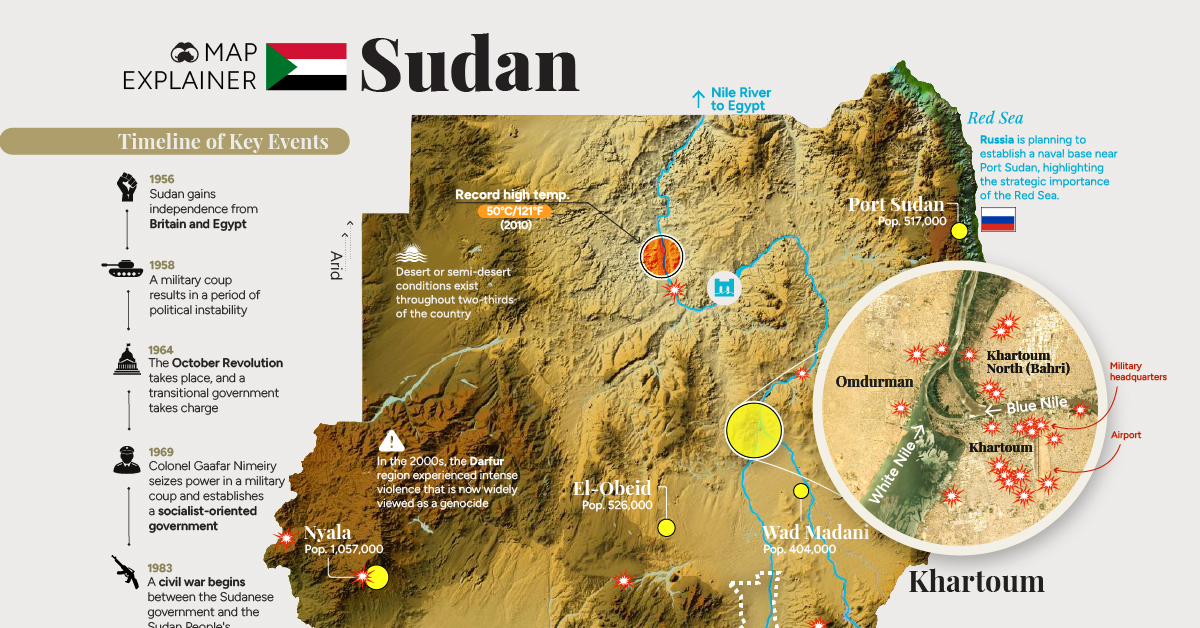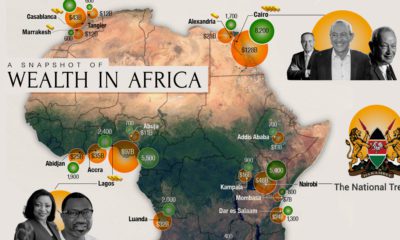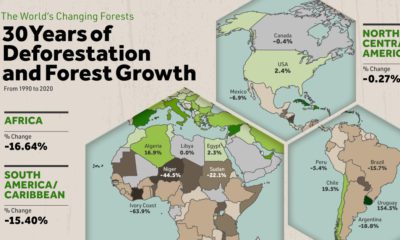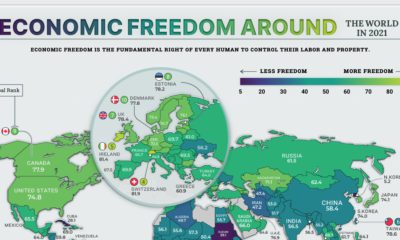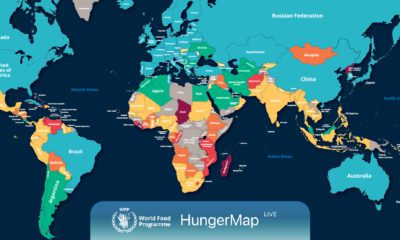War
Map Explainer: Sudan
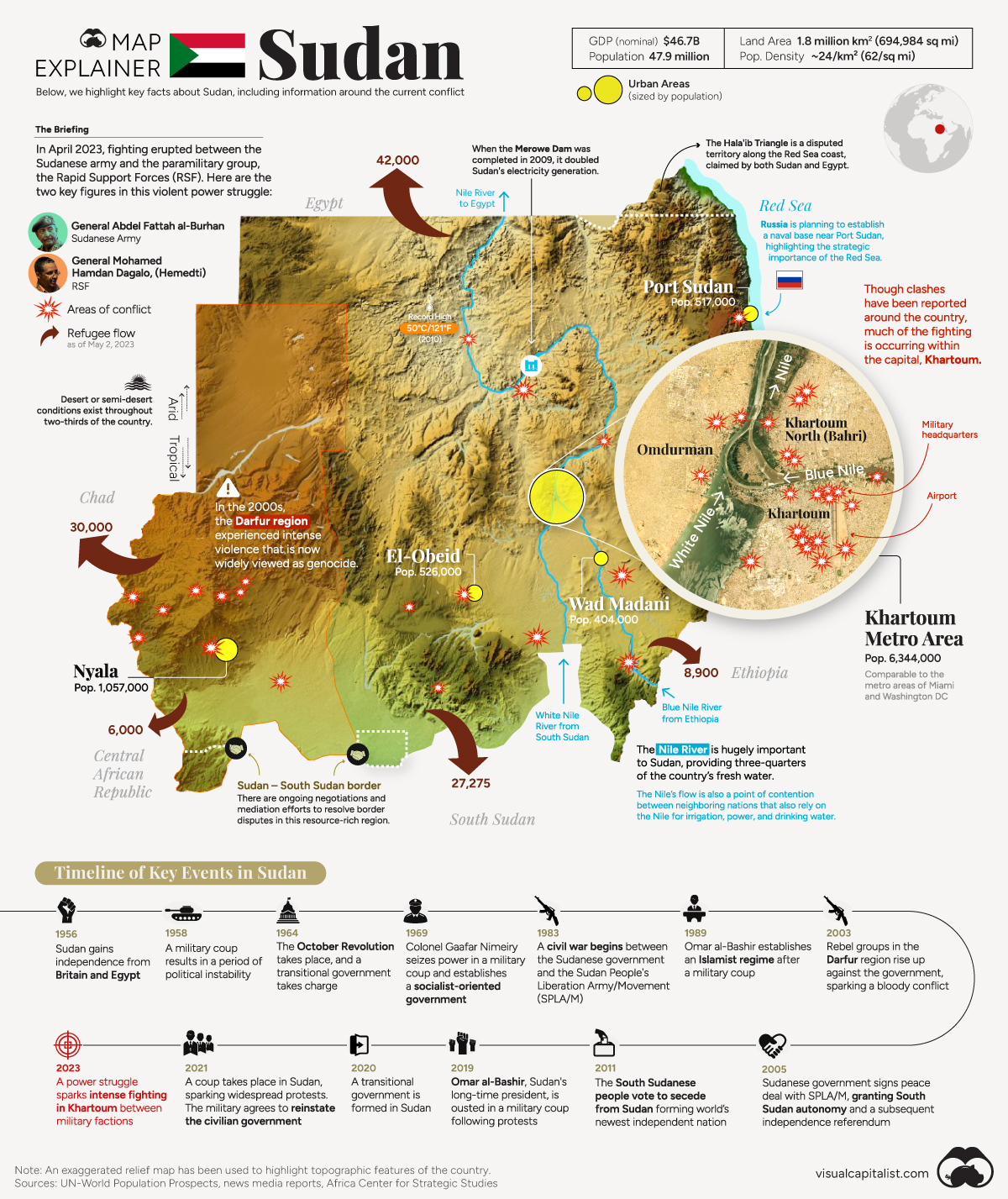
Map Explainer: Sudan
The African nation of Sudan has been in the headlines, as intense fighting has rocked the country. As this bloody power struggle plays out, the map infographic above aims to provides key information on the conflict, as well as general facts and context about the country.
To begin, what exactly is happening in Sudan?
The 2023 Conflict in Sudan: A Primer
As explosions echo throughout Khartoum—Africa’s sixth largest urban area—many around the world are left wondering how the conflict escalated to this point. Here are five things to know:
- Two generals have been sharing power since a coup in 2021. The first is General Abdel Fattah al-Burhan, who leads the Sudanese Army. The second is General Mohamed Hamdan Dagalo (aka Hemedti), who leads the Rapid Support Forces (RSF) paramilitary group. This power-sharing arrangement was meant to be temporary, with an eventual transition to a civilian-led democracy. Instead, the situation devolved into conflict.
- Fighting broke out around the country in mid-April, with Khartoum becoming a major flash point. Flames billowed over the Khartoum airport, and the city’s military headquarters was reduced to a burned-out husk.
- As violence began to grip Sudan’s largest city, there was an exodus of foreign officials and citizens. In one particularly dramatic scene at the U.S. Embassy, nearly 100 people were escorted onto an aircraft by Navy SEALs and flown to nearby Djibouti.
- There have been a number of ceasefire agreements so far, but they’ve done little to stem the intense fighting.
- The stream of refugees fleeing the violence continues to grow. There is growing concern that this conflict will cause further instability in the region, as most of Sudan’s neighbors have their own histories with recent conflict, and many areas are facing food insecurity.
Unfortunately, Sudan is no stranger to conflict, having been ruled by the military for much of its existence. As of the writing of this article, there is technically a ceasefire in place, but fighting rages on. It remains to be seen how far these warring generals are willing to push the situation to assert their power.
Fast Facts About the Country of Sudan
Beyond headlines of conflict, Sudan is not a well-known country to many in the West. In the map above, we’ve also included more general information about geography, climate, population centers, and more.
Geography and Climate
Sudan is the third largest nation in Africa (16th globally), so there is a lot of climate and geographic variance within the country’s borders.
The country is located in Northeast Africa, directly below Egypt. Roughly speaking, its climate changes along a north–south axis, moving from arid to tropical. About two-thirds of the nation is arid and semi-arid, which is typical of countries with territory that includes the Sahara Desert.
The further south one goes in Sudan, the greener the surroundings get. The map below (which also includes the relatively new country of South Sudan) shows the extreme difference in vegetation from the north to south in the region.
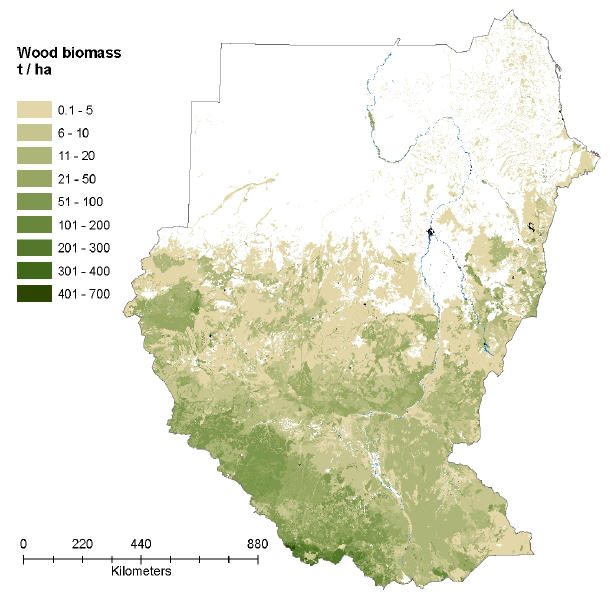
The Nile River is a prominent feature running across this arid region, providing two-thirds of the country’s fresh water. In the south, the Blue and White portions of the Nile enter the country from South Sudan and Ethiopia, respectively. The rivers meet midway through the country and the Nile River flows northward, eventually reaching Egypt.
This flow of water from country-to-country can sometimes be a point of contention between Sudan, South Sudan, Ethiopia, and Egypt, who all rely on the river for power, fresh water, and irrigation.
Population Centers
Over 43 million people live in Sudan, which ranks it ninth in terms of population in Africa. Below, we can see that much of the Sudanese population is clustered in a couple of key areas, while much of the country remains sparsely populated.
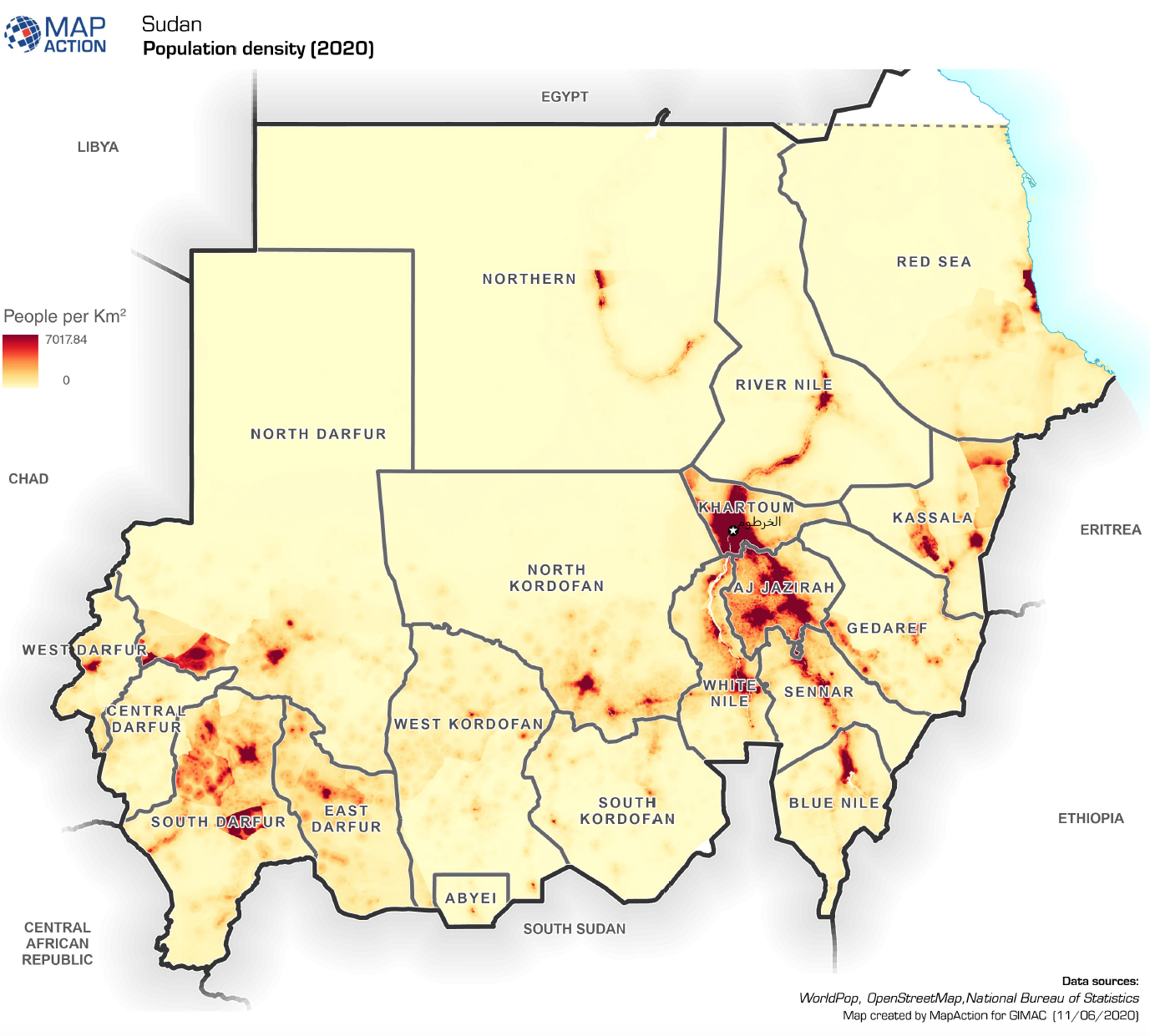
Khartoum, the capital and largest city, is located in the interior of the country at the strategic point where the Blue and White Niles converge. This fast-growing city is shaped by the three sections surrounding the river junction—with Khartoum, North Khartoum, and Omdurman making up a metro area of 6.3 million people.
Sudan is divided into 18 states, five of which form the Darfur region in the west. If the name Darfur is familiar, it’s for good reason. In the 2000s, the region experienced a conflict marked by widespread violence, human rights abuses, and displacement, resulting in a humanitarian crisis. One of the generals involved in the current crisis, Hemedti, previously commanded the Janjaweed militias, which carried out some of the most egregious atrocities of the Darfur conflict.
In the northwest, Sudan borders the strategic Red Sea route. Port Sudan serves as the main entry point for imports and the primary export outlet for Sudanese commodities, including agricultural products (such as cotton, gum arabic, and sesame), minerals (such as gold), and livestock. The city has also been tapped to host a Russian naval base in the near future, though the recent power struggle in Sudan has potentially complicated negotiations.
As violence continues to rage in residential areas and people flee for safer areas, it remains to be seen how this conflict will influence population patterns within the country. How many people will be displaced? And once the smoke clears, will they return?
Countries
Mapped: World’s Top 40 Largest Military Budgets
War in Europe has caused Ukraine’s military spend to jump up by 640%. How do the world’s largest military budgets compare?
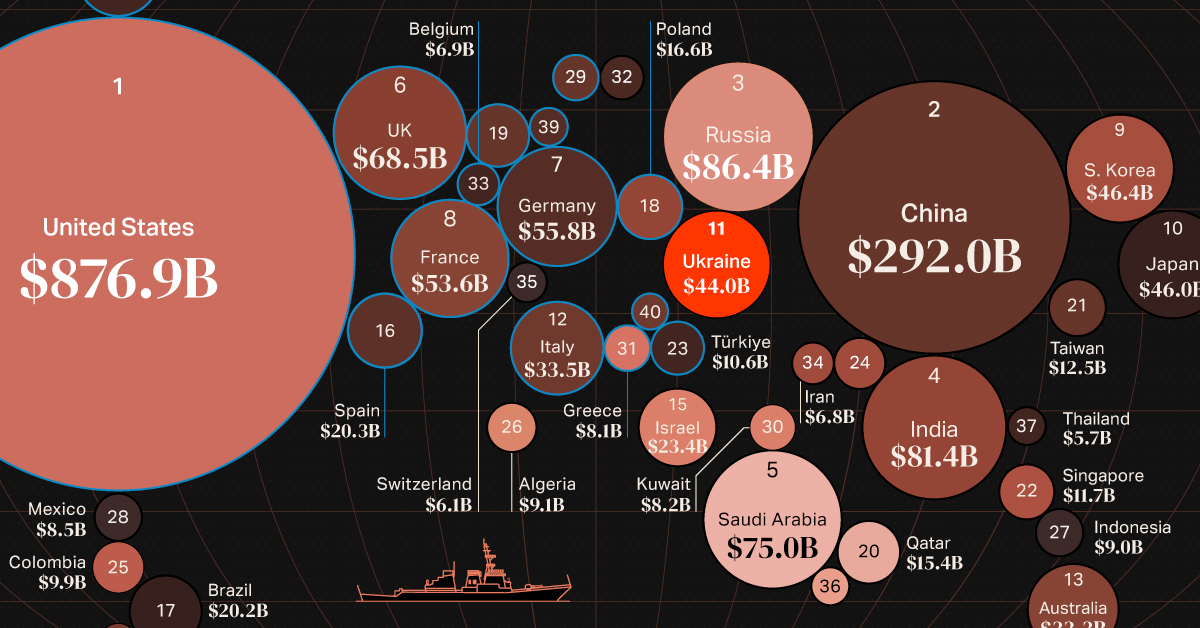
Mapped: World’s Top 40 Largest Military Budgets
In the final year of World War II, the U.S. spent about 38% of its GDP on its military. When adjusted for inflation, the military budget over those four years of war came to a staggering $4.1 trillion in 2020 dollars.
Almost 80 years later, modern day military spending isn’t much of a far cry from World War II budgets. The top spenders have continued to increase their military capabilities, while war in Ukraine has caused countries in the region to re-evaluate their budgets as well.
In 2022, global military budgets hit an all-time high of $2.2 trillion, according to data released by Stockholm International Peace Research Institute (SIPRI), the eighth consecutive year of increase. This post looks at the top 40 largest military budgets in the world.
The Largest Military Budgets in 2022
The United States accounts for almost 40% of global military expenditures, with its 2022 spend coming to $877 billion.
Here are the top 40 largest military budgets in the world for 2022 in U.S. dollars:
| Rank | Country | Military Budget (Billions) | % of World Military Spend |
|---|---|---|---|
| 1 | 🇺🇸 U.S. | $876.9 | 39.0% |
| 2 | 🇨🇳 China | $292.0 | 13.0% |
| 3 | 🇷🇺 Russia | $86.4 | 3.9% |
| 4 | 🇮🇳 India | $81.4 | 3.6% |
| 5 | 🇸🇦 Saudi Arabia | $75.0 | 3.3% |
| 6 | 🇬🇧 UK | $68.5 | 3.1% |
| 7 | 🇩🇪 Germany | $55.8 | 2.5% |
| 8 | 🇫🇷 France | $53.6 | 2.4% |
| 9 | 🇰🇷 South Korea | $46.4 | 2.1% |
| 10 | 🇯🇵 Japan | $46.0 | 2.1% |
| 11 | 🇺🇦 Ukraine | $44.0 | 2.0% |
| 12 | 🇮🇹 Italy | $33.5 | 1.5% |
| 13 | 🇦🇺 Australia | $32.3 | 1.4% |
| 14 | 🇨🇦 Canada | $26.9 | 1.2% |
| 15 | 🇮🇱 Israel | $23.4 | 1.0% |
| 16 | 🇪🇸 Spain | $20.3 | 0.9% |
| 17 | 🇧🇷 Brazil | $20.2 | 0.9% |
| 18 | 🇵🇱 Poland | $16.6 | 0.7% |
| 19 | 🇳🇱 Netherlands | $15.6 | 0.7% |
| 20 | 🇶🇦 Qatar | $15.4 | 0.7% |
| 21 | 🇹🇼 Taiwan | $12.5 | 0.6% |
| 22 | 🇸🇬 Singapore | $11.7 | 0.5% |
| 23 | 🇹🇷 Türkiye | $10.6 | 0.5% |
| 24 | 🇵🇰 Pakistan | $10.3 | 0.5% |
| 25 | 🇨🇴 Colombia | $9.9 | 0.4% |
| 26 | 🇩🇿 Algeria | $9.1 | 0.4% |
| 27 | 🇮🇩 Indonesia | $9.0 | 0.4% |
| 28 | 🇲🇽 Mexico | $8.5 | 0.4% |
| 29 | 🇳🇴 Norway | $8.4 | 0.4% |
| 30 | 🇰🇼 Kuwait | $8.2 | 0.4% |
| 31 | 🇬🇷 Greece | $8.1 | 0.4% |
| 32 | 🇸🇪 Sweden | $7.7 | 0.3% |
| 33 | 🇧🇪 Belgium | $6.9 | 0.3% |
| 34 | 🇮🇷 Iran | $6.8 | 0.3% |
| 35 | 🇨🇭 Switzerland | $6.1 | 0.3% |
| 36 | 🇴🇲 Oman | $5.8 | 0.3% |
| 37 | 🇹🇭 Thailand | $5.7 | 0.3% |
| 38 | 🇨🇱 Chile | $5.6 | 0.2% |
| 39 | 🇩🇰 Denmark | $5.5 | 0.2% |
| 40 | 🇷🇴 Romania | $5.2 | 0.2% |
China, ranked second in absolute terms, accounts for another 13% of world military expenditure at $292 billion.
Russia, India and Saudi Arabia round out the top five biggest military budgets in 2022. Add in the UK to the mix (#6 rank), and these countries all had military expenditures that made up at least 3% of global spend.
Comparatively, the lowest budgets on the top 40 ranged include Romania at $5.2 billion, Denmark at $5.5 billion, and Chile at $5.6 billion. They each account for just 0.2% of the world’s military budgets in 2022, and of course there are many countries with even smaller spends.
Largest Military Budget Increases in 2022
Russia’s position as the third-largest military spender is a recent development, as the country’s military spend had a 9% increase between 2021 and 2022, according to SIPRI estimates.
On the other side of Russia’s invasion, Ukraine was the top 40 military budget with the largest annual increase in 2022, surging nearly six and a half times above its 2021 expenditures.
| Country | % Change (2021-2022) | Rank Change (2021-2022) |
|---|---|---|
| 🇺🇦 Ukraine | 640% | +25 |
| 🇶🇦 Qatar | 27% | +2 |
| 🇸🇦 Saudi Arabia | 16% | +3 |
| 🇧🇪 Belgium | 13% | 0 |
| 🇳🇱 Netherlands | 12% | 0 |
| 🇸🇪 Sweden | 12% | -1 |
| 🇵🇱 Poland | 11% | 0 |
| 🇷🇺 Russia | 9.2% | +2 |
| 🇩🇰 Denmark | 8.8% | +3 |
| 🇪🇸 Spain | 7.3% | -1 |
| 🇳🇴 Norway | 6.2% | 0 |
| 🇮🇳 India | 6.0% | -1 |
| 🇯🇵 Japan | 5.9% | -1 |
| 🇮🇷 Iran | 4.6% | +5 |
| 🇨🇳 China | 4.2% | 0 |
| 🇬🇧 UK | 3.7% | -2 |
| 🇨🇦 Canada | 3.0% | -1 |
| 🇸🇬 Singapore | 2.8% | +1 |
| 🇩🇪 Germany | 2.3% | 0 |
| 🇮🇩 Indonesia | 1.3% | 0 |
| 🇨🇴 Colombia | 1.1% | -1 |
| 🇺🇸 U.S. | 0.7% | 0 |
| 🇫🇷 France | 0.6% | -2 |
| 🇬🇷 Greece | 0.6% | -1 |
| 🇨🇭 Switzerland | 0.4% | -1 |
| 🇹🇼 Taiwan | 0.4% | -1 |
| 🇦🇺 Australia | 0.3% | -1 |
| 🇵🇰 Pakistan | -2.0% | -3 |
| 🇰🇷 South Korea | -2.5% | +1 |
| 🇷🇴 Romania | -2.6% | +1 |
| 🇴🇲 Oman | -3.0% | +1 |
| 🇩🇿 Algeria | -3.7% | -1 |
| 🇮🇱 Israel | -4.2% | -1 |
| 🇮🇹 Italy | -4.5% | -1 |
| 🇨🇱 Chile | -6.2% | -3 |
| 🇧🇷 Brazil | -7.9% | -1 |
| 🇲🇽 Mexico | -9.7% | 0 |
| 🇰🇼 Kuwait | -11% | -4 |
| 🇹🇭 Thailand | -11% | -5 |
| 🇹🇷 Türkiye | -26% | -6 |
Ukraine’s dramatic increase represents the highest single-year jump ever recorded by SIPRI, painting a vivid before-and-after picture of a nation engaged in conflict.
Although no other country comes close in matching Ukraine’s surge in defense spending, Qatar saw a substantial increase of 27% over the last year, marking a continuing trend over the last decade of significantly bolstering its military.
Additionally, Saudi Arabia, along with four European nations (Belgium, the Netherlands, Sweden, and Poland), have registered year-over-year changes of over 10%.
On the flipside, 13 of the nations with the largest military budgets decreased spend from 2021, including top 15 spenders such as South Korea, Italy, and Israel.
The largest drop was seen by Türkiye, with an estimated 26% reduction in military budget. This drop may be linked to Türkiye’s inflation problem, which saw prices rise 72.3% in 2022—effectively decreasing the purchasing power of their currency in relative terms to other nations.
The Specter of War in Europe
With an ongoing conflict in the region and large financial powerhouses, its no surprise that eight of the top 10 countries with the most significant increases in military spending are located in Europe.
Consequently, European military budgets have reached levels not witnessed since the end of the Cold War.
And amid escalating geopolitical concerns, countries in Asia such as India, Japan, and China have also ramped up their defense spending. This is an indication of simmering global flashpoints such as India and China’s border skirmishes, the longstanding South China Sea territorial conflict, and concerns surrounding Taiwan’s sovereignty.
Source: Stockholm International Peace Research Institute (SIPRI).
Data note: SIPRI’s military expenditure data collection began in 1949, thus its records do not account for all expenditure that occurred during both World Wars.
Please see SIPRI’s methodologies page for more details on how they collect their data and create estimates.
-

 Environment5 days ago
Environment5 days agoHotter Than Ever: 2023 Sets New Global Temperature Records
-

 Datastream4 weeks ago
Datastream4 weeks agoCan You Calculate Your Daily Carbon Footprint?
-

 Energy2 weeks ago
Energy2 weeks agoWho’s Still Buying Russian Fossil Fuels in 2023?
-

 VC+4 days ago
VC+4 days agoWhat’s New on VC+ in July
-

 Investor Education4 weeks ago
Investor Education4 weeks agoVisualizing BlackRock’s Top Equity Holdings
-

 apps2 weeks ago
apps2 weeks agoMeet the Competing Apps Battling for Twitter’s Market Share
-

 Politics14 hours ago
Politics14 hours agoHow Do Chinese Citizens Feel About Other Countries?
-

 Markets4 weeks ago
Markets4 weeks agoVisualizing Every Company on the S&P 500 Index




